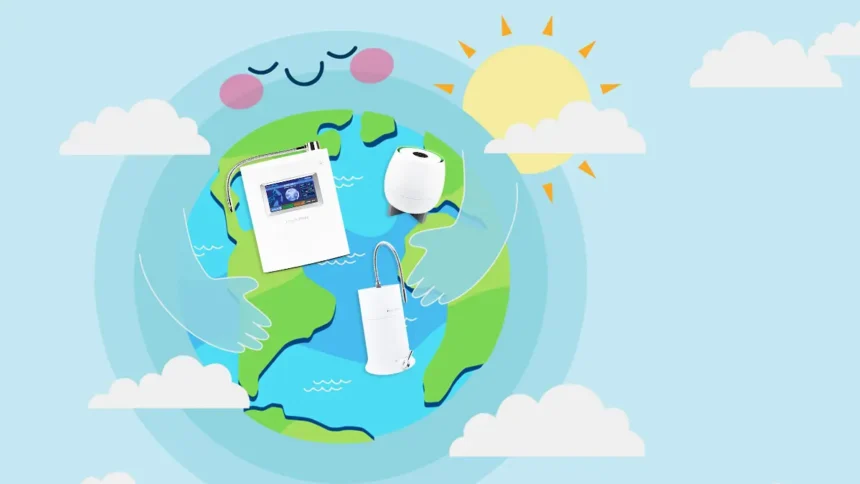Did you know the Earth has to wear sunscreen? Just like our skin gets burnt and blistered by the sun when we don’t protect it, so too would the earth shrivel and burn without its shield: The Ozone Layer.
Not to be confused with ground-level ozone – that harmful ‘smog’-like vapour that ravages our lungs if inhaled – the Ozone Layer is a wonderful, protective layer in the earth’s stratosphere that acts as a giant shield, or sunscreen, wrapped around the earth, protecting it – and US! – from being devastated by UV rays from the sun.
Without protection from the Ozone Layer, plant life would die, which would disrupt the food chain, which would ultimately cause the extinction of all living things on the planet.
But even with the Ozone Layer, we still suffer the negative effects of the sun’s UV rays, evidenced in human illnesses such as skin cancers and cataracts. So, you’d think we’d protect this special sunscreen at all costs, right?
Unfortunately, generations of air pollution and harmful chemicals – particularly chlorofluorocarbons (CFCs) and volatile organic compounds (VOCs) – have wreaked havoc on our planet, especially in producing ground-level ozone (tropospheric ozone) and burrowing a hole in the stratospheric ozone, our Ozone Layer, allowing harsh UV rays to more directly hit and damage our earth.
Why Should We Care?
The thinning of the ozone layer can have several direct and indirect effects on our daily lives:
Increased UV Radiation
One of the most immediate and noticeable impacts is the increase in ultraviolet (UV) radiation reaching the Earth’s surface. This can lead to:
- Skin Damage: Higher levels of UV radiation can cause sunburn, premature ageing of the skin, and an increased risk of skin cancer.
- Eye Damage: Prolonged exposure to increased UV radiation can lead to eye problems, including cataracts and other vision issues.
- Weakened Immune System: Some studies suggest that excessive UV radiation exposure can weaken the immune system, making us more susceptible to infections.
Environmental Effects
The thinning ozone layer also affects the environment, which, in turn, impacts our daily lives:
- Impact on Plant Life: Increased UV radiation can harm crops and reduce agricultural yields, potentially leading to food shortages and higher prices.
- Marine Life: UV radiation can penetrate the ocean’s surface, harming marine ecosystems, including coral reefs and phytoplankton, which are vital for the food chain.
- Climate Change: Ozone depletion can alter atmospheric circulation patterns, influencing weather and climate conditions worldwide, which can have cascading effects on agriculture, water resources, and extreme weather events.
Healthcare Costs
The rise in skin cancer cases and other UV-related health issues due to ozone depletion can increase healthcare costs for individuals and governments alike.
Product Changes
To mitigate the effects of increased UV radiation, people may need to purchase and use more sunscreens, sunglasses, and protective clothing, impacting personal expenses.
Air Quality
While the thinning ozone layer doesn’t directly affect air quality, efforts to combat ozone depletion have led to changes in the use of chemicals, such as the phase-out of ozone-depleting substances. This can have positive effects on air quality, reducing respiratory issues and improving overall health.
Travel and Tourism
Increased UV radiation can make outdoor activities less enjoyable, impacting tourism and outdoor recreational industries. People may also need to take extra precautions when travelling to regions with higher UV levels.
What Can You Do To Protect the Ozone Layer?
Today, 16 September, marks the day that the United Nations draws international attention to the importance of the earth’s sunscreen, with the International Day for the Preservation of the Ozone Layer, or World Ozone Day. Everyone is encouraged to get involved in any way they can.
Plant a tree or two

Simple, yet one of the most effective ways to reduce carbon dioxide levels while adding to the oxygen in the atmosphere, which helps to preserve the Ozone Layer, is to plant more trees.
Reduce chemical use
Especially chlorofluorocarbons (CFCs), but reducing the use of any and all chemicals is a positive step towards safeguarding our earth. Water ionisers that can change the pH level of water to minimise the use of chemicals in basic cleaning and disinfecting – such as QNET’s HomePure Viva Water Ioniser – are one way to reduce the use of chemicals in your own home.
Ditch the car and walk or cycle
Reducing carbon emissions in any way you can is a real way to acknowledge and participate in World Ozone Day and encourage others to do the same.
Reduce your contribution to air pollution
VOCs are created in the breakdown of organic matter, such as feed and manure, and are detrimental to the environment and a considerable contributor to poor air quality. Air filters and purifiers, such as QNET’s HomePure Zayn Air Purifier, can actively remove VOCs from the air.
These are what we aim to practise every day as part of our commitment to our QNET sustainability efforts. Remember, our actions aren’t just about protecting the Ozone Layer; they’re about ensuring a better quality of life for ourselves, our families, and future generations. Let’s make every day an Earth-friendly day and contribute to the lasting sustainability of our world.







Good production. And also the effects are a good fitness